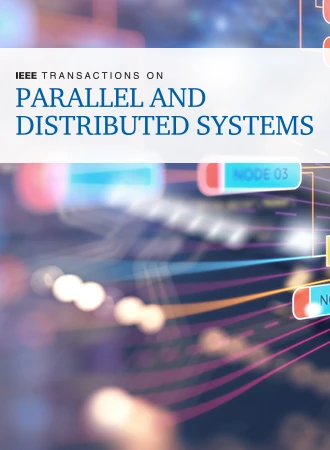Logical Synchrony and the Bittide Mechanism
IF 5.6
2区 计算机科学
Q1 COMPUTER SCIENCE, THEORY & METHODS
IEEE Transactions on Parallel and Distributed Systems
Pub Date : 2024-08-16
DOI:10.1109/TPDS.2024.3444739
引用次数: 0
Abstract
We introduce logical synchrony, a framework that allows distributed computing to be coordinated as tightly as in synchronous systems without the distribution of a global clock or any reference to universal time. We develop a model of events called a logical synchrony network, in which nodes correspond to processors and every node has an associated local clock which generates the events. We construct a measure of logical latency and develop its properties. A further model, called a multiclock network, is then analyzed and shown to be a refinement of the logical synchrony network. We present the bittide mechanism as an instantiation of multiclock networks, and discuss the clock control mechanism that ensures that buffers do not overflow or underflow. Finally we give conditions under which a logical synchrony network has an equivalent synchronous realization.逻辑同步和比特机制
我们介绍了逻辑同步,这是一个允许分布式计算像同步系统一样紧密协调的框架,而无需分配全局时钟或参考通用时间。我们建立了一个称为逻辑同步网络的事件模型,其中的节点与处理器相对应,每个节点都有一个相关的本地时钟来产生事件。我们构建了逻辑延迟的测量方法,并发展了其特性。然后,我们分析了另一种称为多时钟网络的模型,并证明它是逻辑同步网络的一种改进。我们介绍了作为多时钟网络实例化的比特化机制,并讨论了确保缓冲区不会溢出或下溢的时钟控制机制。最后,我们给出了逻辑同步网络具有等效同步实现的条件。
本文章由计算机程序翻译,如有差异,请以英文原文为准。
求助全文
约1分钟内获得全文
求助全文
来源期刊

IEEE Transactions on Parallel and Distributed Systems
工程技术-工程:电子与电气
CiteScore
11.00
自引率
9.40%
发文量
281
审稿时长
5.6 months
期刊介绍:
IEEE Transactions on Parallel and Distributed Systems (TPDS) is published monthly. It publishes a range of papers, comments on previously published papers, and survey articles that deal with the parallel and distributed systems research areas of current importance to our readers. Particular areas of interest include, but are not limited to:
a) Parallel and distributed algorithms, focusing on topics such as: models of computation; numerical, combinatorial, and data-intensive parallel algorithms, scalability of algorithms and data structures for parallel and distributed systems, communication and synchronization protocols, network algorithms, scheduling, and load balancing.
b) Applications of parallel and distributed computing, including computational and data-enabled science and engineering, big data applications, parallel crowd sourcing, large-scale social network analysis, management of big data, cloud and grid computing, scientific and biomedical applications, mobile computing, and cyber-physical systems.
c) Parallel and distributed architectures, including architectures for instruction-level and thread-level parallelism; design, analysis, implementation, fault resilience and performance measurements of multiple-processor systems; multicore processors, heterogeneous many-core systems; petascale and exascale systems designs; novel big data architectures; special purpose architectures, including graphics processors, signal processors, network processors, media accelerators, and other special purpose processors and accelerators; impact of technology on architecture; network and interconnect architectures; parallel I/O and storage systems; architecture of the memory hierarchy; power-efficient and green computing architectures; dependable architectures; and performance modeling and evaluation.
d) Parallel and distributed software, including parallel and multicore programming languages and compilers, runtime systems, operating systems, Internet computing and web services, resource management including green computing, middleware for grids, clouds, and data centers, libraries, performance modeling and evaluation, parallel programming paradigms, and programming environments and tools.
 求助内容:
求助内容: 应助结果提醒方式:
应助结果提醒方式:


